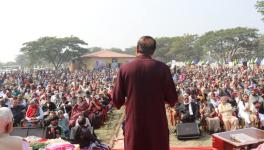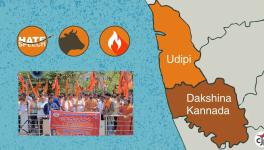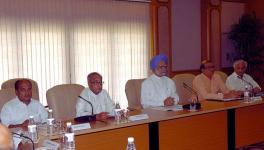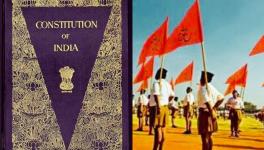Have Farmers Stalled the Hindutva Juggernaut?
File Photo.
It is time for Hindutva to watch out. The Narendra Modi government is facing a political challenge as never before. The challenge is daunting because it emanates from no political party but loosely-organized farmers. Spearheaded by Punjabi farmers, the agitation is gaining in strength every passing day, with more farmers from all over India joining.
Reminiscent of the 1988 Bharatiya Kisan Union-led farmers rally in Delhi, the present protests have assumed importance for their same apolitical nature. That has made the Bharatiya Janata Party’s job difficult. Until now, the BJP has successfully played its Hindutva card to dominate the political narrative and trounce its political opponents. The question therefore is, will the farmers’ agitation make the Hindutva juggernaut halt and allow a return to a level-playing field in Indian politics.
The BJP’s electoral gains over the years have been striking, including those in the recently held Greater Hyderabad municipal election. From a bare four in 2016, it won as many as 48 municipal divisions (out of 150) in elections earlier this month. Its vote percentage also rose massively to 34.56 points, which almost matched that of the regionally unbeatable Telangana Rashtra Samithi (TRS).
The Hyderabad showing was right on the heels of its victory in the Bihar elections held in October-November. There the BJP emerged as the dominant partner in the ruling National Democratic Alliance (NDA), relegating to the background its more powerful regional ally, Chief Minister Nitish Kumar’s Janata Dal United (JDU). Had the BJP wanted, it could have claimed the post of chief minister, but keeping larger strategic interests in mind it let Nitish Kumar retain the position. The latter is no doubt aware that a small misstep and the BJP will replace him without much ado.
Whether in Bihar or in Hyderabad, the political card the BJP most vociferously displayed was that of Hindutva. There was extravagant use of such catchphrases as: “beware of the divisive forces”; “look out for the Pakistani lackeys”; “condemn the pseudo secularists”; “drive out the Rohingya migrants”; “remember who were behind the terrorist attack in Pulwama”; “change the name from Hyderabad to Bhagyanagar (evoking the renaming of Allahabad and Mughal Sarai Junction as Prayagraj and Deen Dayal Upadhyay Junction, respectively”) and finally, perhaps the most ludicrous of them all, “there will be ‘surgical strikes’ to drive out all illegal Bangladeshis”.
These tongue-in-cheek and demonstrably false contentions had little relevance for local politics but because they were dished out directly by the likes of Narendra Modi, Amit Shah, JP Nadda, and other top BJP leaders they were powerful enough to influence voters. Considering discretion the better part of valour, most other parties steered clear of the communal question by emphasising seemingly more mundane matters. In Bihar, for example, the Tejaswi Yadav-led Rashtriya Janata Dal (RJD) danced to just one tune, the problem of unemployment. That it emerged as the single largest party and also won the popular vote by a significant margin serves as a warning to the BJP about the efficacy of Hindutva as an all-weather weapon. Still, Hindutva has not lost its shine.
In such circumstances, many Muslims in the Muslim-majority areas of Bihar increasingly gravitated towards the Hyderabad-based, Asaduddin Owaisi-led AIMIM (All India Majlis-e-Ittehad-ul-Muslimeen—All India Council for Unity of Muslims). And although Owaisi is no twenty-first century Mohammed Ali Jinnah out to divide the country, his success no doubt pleases the BJP, which would love to see an Owaisi-driven polarizing drive succeed, thereby further consolidating its Hindu constituency. After all, greater the Hindu-Muslim communal polarisation, better the prospects for Hindutva to perpetuate its appeal.
Against this background of business-as-usual success, the BJP could scarcely have imagined that their Hindutva juggernaut would come to a grinding halt in the face of roadblocks mounted by the innocuous Sikh farmers of Punjab. It is the first time since Modi’s elevation to power in 2014 that his government has not been able to browbeat protesters in the name of national security. The Sikh farmers have (so far) succeeded where the nation-wide cross-community protests by university students (including those from JNU) and anti-CAA protesters (led by common Muslims of Delhi) had failed.
Not that the BJP has not tried to make use of their well-tested deceptions to discredit the farmers. Most unabashedly, they branded the protesting Sikh farmers as secessionist Khalistanis who were being sponsored by forces from across the border, meaning Pakistan and China. Ever since the recent border row between India and China, “foreign hand” has conveniently begun to connote not just Pakistanis, but the Chinese as well. (During Indira Gandhi’s time, these “foreign hands” signaled American interference.)
Some BJP bigwigs even went to the extent of questioning the credentials of the farmers. VK Singh, Minister of State for Road Transport and Highways, placed his foot squarely in his mouth when he declared that he could tell from their dress that they were not farmers. How could a farmer, who is expected to be poor and in tattered clothes, look so well-fed and well-dressed? Obviously, this was what Minister Singh meant. One may recall that during the Jharkhand assembly election last year, Narendra Modi had similarly derided the Muslims who formed the bulk of the anti-CAA protesters in Delhi’s Shaheen Bagh area. As if the Shaheen Bagh protesters had tried to conceal or were embarrassed by who they were.
Thanks to COVID-19 restrictions and certain recent Supreme Court rulings, street protests and open-air gatherings have been virtually delegitimized, granting unfettered reign to the BJP’s anti-Muslim rhetoric. The BJP has also used this opportunity to pass one legislation after another, riding roughshod over legislative procedures. They have also let loose their social media troll army to browbeat all liberal, not necessarily anti-BJP, sentiments. Thus, even the depiction in A Suitable Boy of a kiss between a Hindu girl and a Muslim boy on the premises of a Hindu temple was enough to provoke demands that Netflix pull the show. A more subtle interpretation of the scene—that there is a Hindu temple in every nook and cranny of this country—was perhaps too much to expect from the rabble.
In any case, India’s Muslims have been systematically marginalised thanks to the post-Nehruvian politics and do not constitute Hindutva’s biggest enemy. The real enemies are the forces of democracy and liberal politics, both of which have been in steady retreat since 2014. But Muslims are important to the Hindutva project because their demonisation keeps India’s Hindu majority distracted, suppressing their inner societal and cultural contradictions.
From the beginning, the guardians of Hindutva know that so long as the marginal social classes within the Hindu fold have a sense of political and legal oneness with the upper castes, they will remain satisfied, their actual societal suppression notwithstanding. The Uttar Pradesh government may trumpet their recent anti-love jihad law, when of all marriages in the country only three to four percent are inter-faith (likely even fewer in Uttar Pradesh), but have they taken even a single step in the direction of encouraging intercaste marriages among the Hindus? If and when Hindutva takes this up as its crusading motto, it will have takers even among the “libtards” and “sickulars”.
In light of the foregoing discussion, the farmers’ agitation assumes importance because it shows that Indian politics should have concerns other than merely the Hindu-Muslim question, which the BJP has mastered to its advantage by posing it as the central question. Nobody knows what the ultimate outcome of the faceoff between the farmers and the state will be, but the visible climb down by the latter is a good omen for Indian democracy because in the process many other issues will also come to the surface. These include the indiscriminate arrests of activists and journalists in the name of national security and the overall deterioration of legislative and judicial processes.
Let me end this essay by asking the BJP one simple question. If everything is hunky-dory—India’s growth story is in place, its indigenous anti-COVID vaccine is just a test away, all Muslim nations of the Gulf region are on best terms with India, the Americans are committed to sharing their sophisticated defence technologies, all conflicts with China are being coolly sorted out, farmers are all set to double their income in two years, the Kashmir problem is solved as it is now fully integrated into India, and, most importantly, India is now a corruption-free nation, for the first time since independence—then why are India’s Hindus (who comprise 80% of the country) being made to feel so insecure about the country’s politically and economically marginalised Muslims? Why must the community necessarily be demonised during every election, whether national, assembly or municipal?
In the forthcoming West Bengal Assembly election, we will see this naked communal dance as never before. The pro-CAA and anti-Muslim bugles are already audible. It is just a matter of days before the sound becomes deafening. Who cares about the inevitable fallout in neighbouring Bangladesh, where about twenty million Hindus reside? It seems that for the BJP government the seventeenth century Treaty of Westphalia is their Bible. It has taught them that cartographically Bangladesh is another country and hence India’s domestic politics end at India’s Bangladesh border. I wish Prime Minister Sheikh Hasina Wajed had also read the same treaty text and had internalised its inherent ethos exactly the same way.
Postscript: In the 2019 Central Services Mains Examination conducted by India’s Union Public Service Commission (UPSC), Question No. 10 of General Studies Paper 1 read as follows: “What are the challenges to our cultural practices in the name of secularism?” In earlier days, when the word “secular” had not been mocked as “sickular”, the question would probably have been phrased differently: “What are the challenges to secularism in the name of our cultural practices?” More than the answers they may generate, it is the vast gulf between the questions themselves that reveals how much has changed in India’s secular moorings.
The author is a senior fellow at the Institute of Social Sciences, New Delhi. He is a former ICSSR National Fellow and professor of South Asian Studies at JNU. The views are personal.
Get the latest reports & analysis with people's perspective on Protests, movements & deep analytical videos, discussions of the current affairs in your Telegram app. Subscribe to NewsClick's Telegram channel & get Real-Time updates on stories, as they get published on our website.























